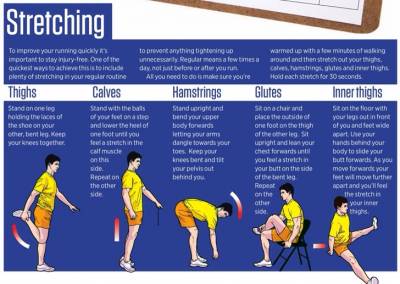Importance of Stretching Before a Workout


Why it’s important. Stretching keeps the muscles flexible, strong, and healthy, and we need that flexibility to maintain a range of motion in the joints. Without it, the muscles shorten and become tight. Then, when you call on the muscles for activity, they are weak and unable to extend all the way.
Stretching helps you maintain optimal joint function for athletic performance. While the benefits of stretching before running have not been conclusively proven or disproven, stretching is still recommended as part of an overall running regimen, preferably after you have performed a warm-up. Before you stretch, consider some basic guidelines to optimize your results.
Warm Muscles Respond Best
Stretching is best performed when your muscle fibers are warm. Stretching a cold muscle can result in microtears in the muscle fibers and fascia that lead to pain and increased stiffness. Before stretching, perform a brief warm up consisting of five to 10 minutes of moderate intensity cardio. You can also warm your muscles by taking a hot bath or shower, or using a sauna. Dynamic stretches performed before your run can increase your muscle spindle length and prepare your muscles for activity. Static stretches after your run can help your muscles relax and restore them to their resting length.
Dynamic Pre-Run Stretching
Dynamic stretching can help improve blood flow and lubricate joints and muscles, which is why it purportedly helps avoid injuries. Dynamic stretching involves moving your joints through their greatest range of motion in a repetitive rhythmic pattern. A good dynamic pre-run stretch is a forward and back leg swing to optimize your groin muscle range of motion. Support yourself next to a wall or post and hold your trunk erect with contracted abs. Kick your outside leg forward from the hip as high as it will go, then swing it back as far as it will go. Repeat 10 times, increasing the arc of swing with each repetition. Do three sets on each leg.
Static Pre-Run Stretching
After warming up and performing dynamic stretches, you can add static stretches. A static stretch takes your muscle to its longest length and holds it there for an extended time, usually about 15 to 60 seconds. You should always relax into your static stretch while breathing rhythmically. Do not bounce into your stretch, as it is likely to tear muscle fibers. Static stretches may be more beneficial at the end of your run, to restore muscle fiber length and relax your muscles.
Recommendations
According to a 2004 study published in the “Clinical Journal of Sports Medicine”, regular stretching improves force, jump height, and speed, although there is no evidence that it improves running economy. If you choose to stretch before you run, warm up for five to 10 minutes by jogging or walking. The journal “Marathon Training” recommends that runners focus on stretching all the major leg muscle groups including your calves, hamstrings, quadriceps, groin and hip flexors.
ABOUT MICHIGAN SPORTS & SPINE CENTER:
We’re innovative leaders utilizing cutting-edge technologies such as musculoskeletal ultrasounds, PRP, stem cell treatment, and other innovative procedures. Michigan Sports & Spine Center is committed to resolving your pain, not simply masking it. We treat the whole body, not just the injury, and perform preventative treatment so your injury doesn’t come back. Our studies prove that Michigan Sports & Spine Center has patient success rates much higher than the national average. We treat everyone from high-profile athletes to your neighbor next door. Our primary focus is getting our patients back into the game of life!
